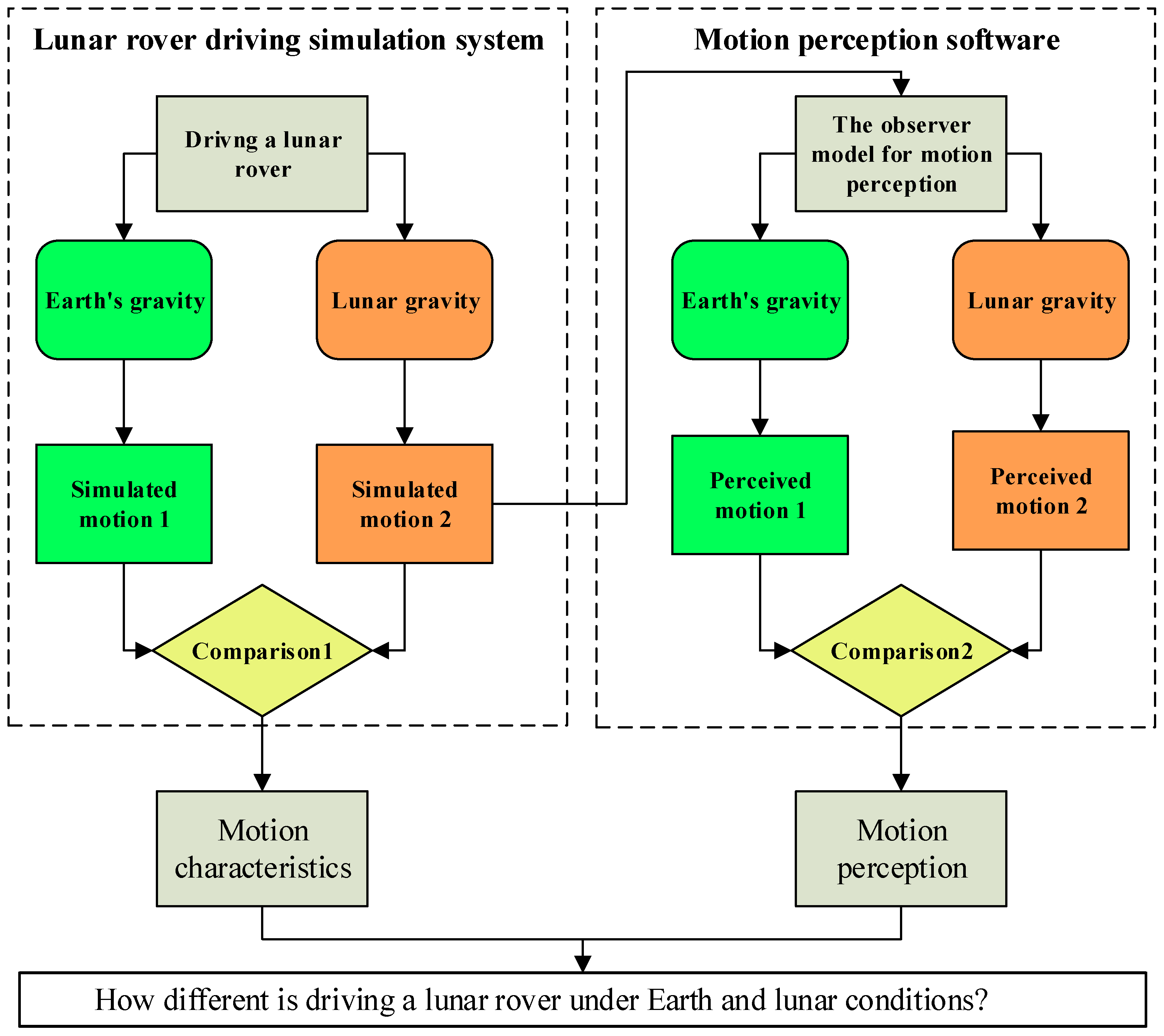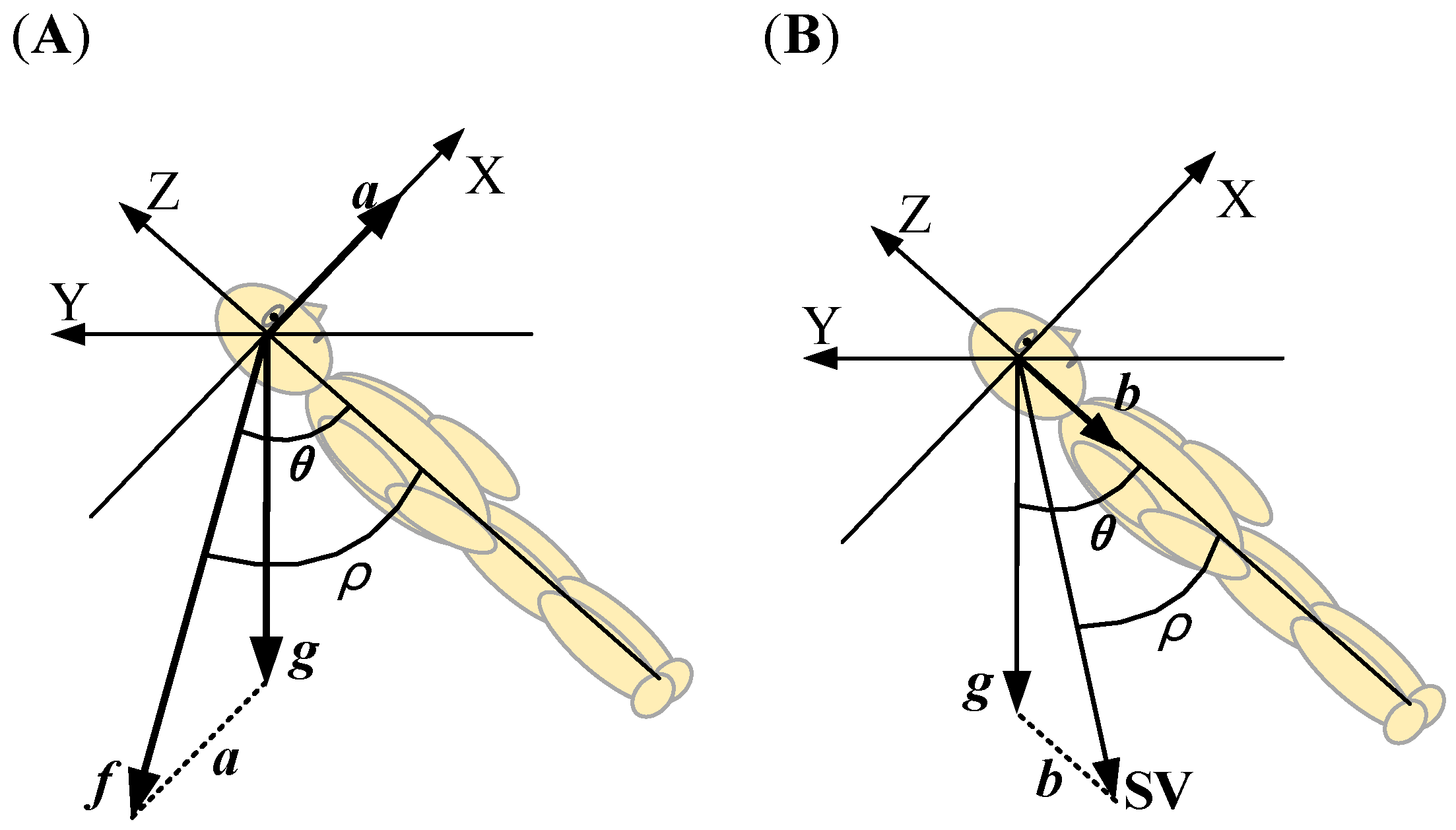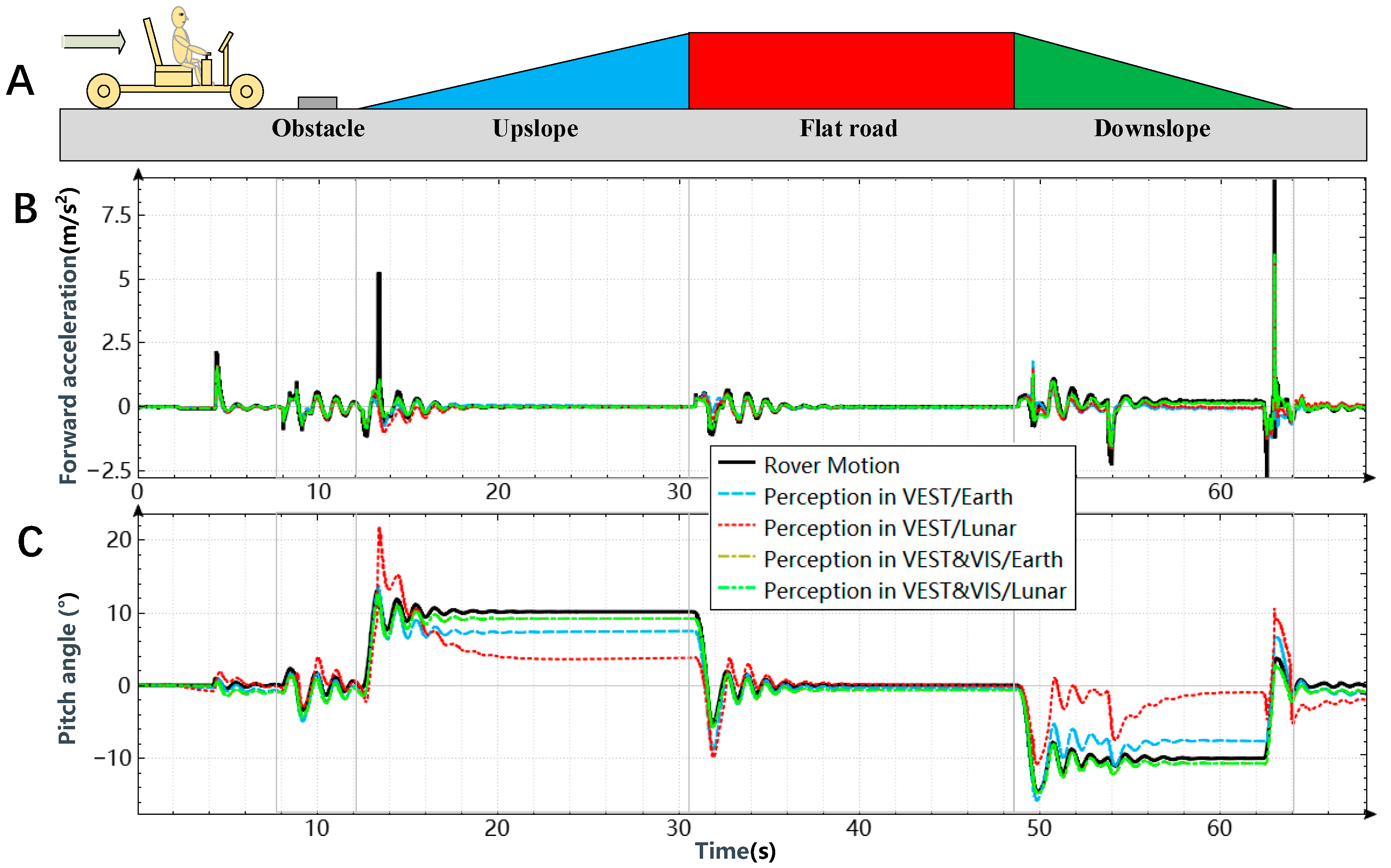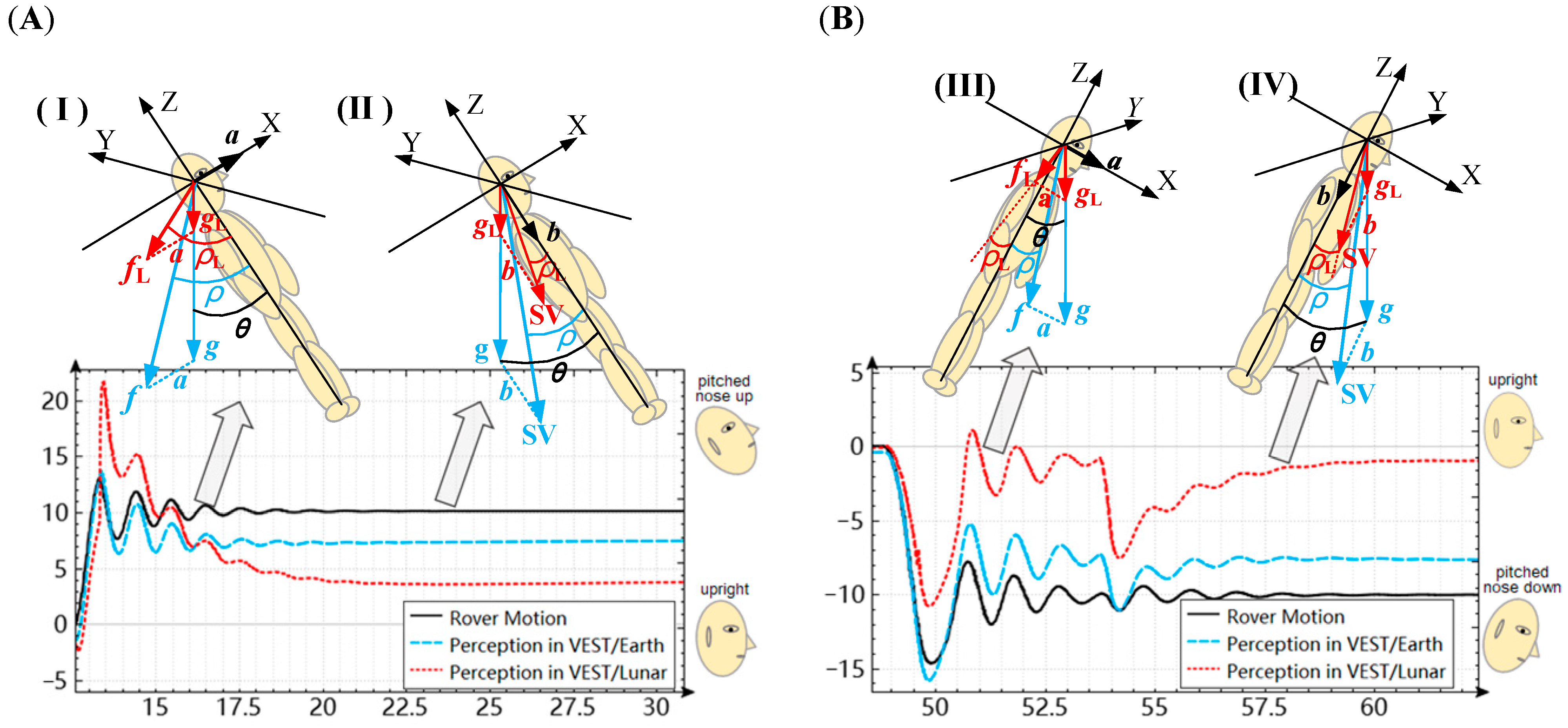Motion Perception Simulation for Lunar Rover Driving Using the Spatial Orientation Observer Model
Abstract
1. Introduction
2. Materials and Methods
2.1. Lunar Rover Driving Simulation System
2.2. Motion Perception Software
3. Results
3.1. Simulation Comparison of Motion Characteristics for Lunar Rover Driving
3.2. Simulation Comparison of Motion Perception for Lunar Rover Driving
4. Discussion
4.1. Motion Characteristics Between the Simulated Earth and Lunar Conditions
4.2. Motion Perception with Single Vestibular Information
4.3. Motion Perception with the Vestibular and Visual Information
4.4. Limitations
5. Conclusions
Author Contributions
Funding
Data Availability Statement
Conflicts of Interest
Abbreviations
| LRV | Lunar Roving Vehicle |
| DEM | Digital elevation model |
| DOM | Digital orthophoto map |
| ADAMS | Automatic Dynamic Analysis of Mechanical Systems |
References
- Clark, T.K. Sensorimotor challenges for crewed lunar surface missions, analogs, and countermeasures. In Proceedings of the AIAA SCITECH 2022 Forum, San Diego, CA, USA & Virtual, 3–7 January 2022. [Google Scholar] [CrossRef]
- Rosenberg, M.J.; Galvan-Garza, R.C.; Clark, T.K.; Sherwood, D.P.; Young, L.R.; Karmali, F. Human manual control precision depends on vestibular sensory precision and gravitational magnitude. J. Neurophysiol. 2018, 120, 3187–3197. [Google Scholar] [CrossRef] [PubMed]
- Kubis, J.F.; Elrod, J.T.; Rusnak, R.; Barnes, J.E. Apollo 15 Time and Motion Study. NASA Technical Report, No. NASA-CR-128695. 1972. Available online: https://ntrs.nasa.gov/citations/19730008096 (accessed on 2 September 2013).
- Young, A.H. Training for the Moon. In Lunar and Planetary Rovers: The Wheels of Apollo and the Quest for Mars. Springer Praxis Books; Springer: New York, NY, USA, 2007; pp. 57–84. [Google Scholar] [CrossRef]
- Litaker, H.L.; Vos, G.A.; Liberman, A.P.; Bingham, L.K.; Jones, V.L.; Gelo, T.J.; Cramer, M.O.; Scharunovych, N.; Frangoudis, A.A.; Royer, J.M. Developing a motion-based system for lunar vehicle handling qualities testing. In Proceedings of the IEEE Aerospace Conference, Big Sky, MT, USA, 2–9 March 2024; pp. 1–22. [Google Scholar] [CrossRef]
- Clark, T.K.; Stimpson, A.J.; Young, L.R.; Oman, C.M.; Natapoff, A.; Duda, K.R. Human spatial orientation perceptions during simulated lunar landing motions. AIAA J. Rocket. 2014, 51, 267–280. [Google Scholar] [CrossRef]
- Galvan-Garza, R.C.; Clark, T.K.; Sherwood, D.; Diaz-Artiles, A.; Rosenberg, M.J.; Natapoff, A.; Karmali, F.; Oman, C.M.; Young, L.R. Human perception of whole body roll-tilt orientation in a hypogravity analog: Underestimation and adaptation. J. Neurophysiol. 2018, 120, 3110–3121. [Google Scholar] [CrossRef] [PubMed]
- Meskers, A.J.H.; Houben, M.M.J.; Pennings, H.J.M.; Clément, G.; Groen, E.L. Underestimation of self-tilt increases in reduced gravity conditions. J. Vestib. Res. 2021, 31, 345–352. [Google Scholar] [CrossRef]
- Bos, J.E.; Bles, W. Theoretical considerations on canal–otolith interaction and an observer model. Biol. Cybern. 2002, 86, 191–207. [Google Scholar] [CrossRef]
- Merfeld, D.M.; Young, L.R.; Oman, C.M.; Shelhamert, M.J. A multidimensional model of the effect of gravity on the spatial orientation of the monkey. J. Vestib. Res. 1993, 3, 141–161. [Google Scholar] [CrossRef]
- Clark, T.K.; Newman, M.C.; Karmali, F.; Oman, C.M.; Merfeld, D.M. Mathematical models for dynamic, multisensory spatial orientation perception. Prog. Brain Res. 2019, 248, 65–90. [Google Scholar] [CrossRef]
- Lewkowicz, R. A modelling approach to the human perception of spatial orientation. Pol. J. Aviat. Med. Bioeng. Psychol. 2016, 22, 27–42. [Google Scholar] [CrossRef]
- Newman, M.C. A Multisensory Observer Model for Human Spatial Orientation Perception. Doctoral Dissertation, Massachusetts Institute of Technology, Cambridge, MA, USA, 2009. Available online: http://dspace.mit.edu/handle/1721.1/7582 (accessed on 24 November 2009).
- Clark, T.K.; Young, L.R.; Stimpson, A.J.; Duda, K.R.; Oman, C.M. Numerical simulation of human orientation perception during lunar landing. Acta Astronaut. 2011, 69, 420–428. [Google Scholar] [CrossRef]
- Meyer, T.H. The discontinuous nature of kriging interpolation for digital terrain modeling. Cartogr. Geogr. Inform. Sci. 2004, 31, 209–216. [Google Scholar] [CrossRef]
- Bo, Z.; Di, K.; Liu, Z.; Yue, Z.; Liu, J.; Shi, K. A catalogue of meter-scale impact craters in the Chang’e-5 landing area measured from centimeter-resolution descent imagery. Icarus 2022, 378, 114943. [Google Scholar] [CrossRef]
- Di, K.; Xu, B.; Peng, M.; Yue, Z.; Liu, Z.; Wan, W.; Li, L.; Zhou, J. Rock size-frequency distribution analysis at the Chang’E-3 landing site. Planet. Space Sci. 2016, 120, 103–112. [Google Scholar] [CrossRef]
- Yang, M.; Yue, Z.; Di, K.; Wan, W.; Liu, J.; Shi, K. Statistical Analysis of Secondary Craters in the Chang’E-4 Landing Area Based on Panoramic Camera Data. Bull. Mineral. Petrol. Geochem. 2021, 40, 720–729. [Google Scholar] [CrossRef]
- Bonecracker Games. Realistic Car Controller. Available online: https://www.bonecrackergames.com/realistic-car-controller (accessed on 15 June 2023).
- Xie, Y.Z.; Tang, Z.H.; Song, A.G. Motion Simulation and Human-Computer Interaction System for Lunar Exploration. Appl. Sci. 2022, 12, 2312. [Google Scholar] [CrossRef]
- Vingerhoets, R.A.; Van Gisbergen, J.A.; Medendorp, W.P. Verticality perception during off-vertical axis rotation. J. Neurophysiol. 2007, 97, 3256–3268. [Google Scholar] [CrossRef][Green Version]
- Chen, W.; Chao, J.-G.; Wang, J.-K.; Chen, X.-W.; Tan, C. Subjective vertical conflict theory and space motion sickness. Aerosp. Med. Hum. Perform. 2016, 87, 128–136. [Google Scholar] [CrossRef]
- Mittelstaedt, H. A new solution to the problem of the subjective vertical. Naturwissenschaften 1983, 70, 272–281. [Google Scholar] [CrossRef]
- Dyde, R.T.; Jenkin, M.R.; Harris, L.R. The subjective visual vertical and the perceptual upright. Exp. Brain Res. 2006, 173, 612–622. [Google Scholar] [CrossRef]
- Costes, N.C.; Farmer, J.E.; George, E.B. Mobility Performance of the Lunar Roving Vehicle: Terrestrial Studies, Apollo 15 Results. NASA Technical Report, NASA TR R-401. 1972; pp. 47–57. Available online: https://ntrs.nasa.gov/citations/19730008090 (accessed on 2 September 2013).
- Rodríguez-Martínez, D.; Van Winnendael, M.; Yoshida, K. High-speed mobility on planetary surfaces: A technical review. J. Field Robot. 2019, 36, 1436–1455. [Google Scholar] [CrossRef]
- Columbus, C. Apollo 16 Technical Crew Debriefing; NASA: Houston, TX, USA, 1972; pp. 141–258.
- Harris, L.R.; Herpers, R.; Hofhammer, T.; Jenkin, M. How much gravity is needed to establish the perceptual upright? PLoS ONE 2014, 9, e106207. [Google Scholar] [CrossRef]
- de Winkel, K.N.; Clément, G.; Groen, E.L.; Werkhoven, P.J. The perception of verticality in lunar and Martian gravity conditions. Neurosci. Lett. 2012, 529, 7–11. [Google Scholar] [CrossRef] [PubMed]
- Clark, T.K.; Young, L.R. A case study of human roll tilt perception in hypogravity. Aerosp. Med. Hum. Perform. 2017, 88, 682–687. [Google Scholar] [CrossRef]







| Parameter | Value | Parameter | Value |
|---|---|---|---|
| Rover mass | 500 kg | Wheel mass | 8 kg |
| Max speed | 4.4 m/s | Wheel radius | 0.35 m |
| Engine torque | 170 Nm | Wheel bounciness | 0.5 |
| Dynamic friction | 0.15 | Wheel type choice | 4 WS * |
| Static friction | 0.1 | Suspension distance | 0.24 m |
| Parameter | Value | Parameter | Value |
|---|---|---|---|
| K1 | 1 | Kfω | 8 |
| Kau | −2 | KpV | 0.1 |
| Kau⊥ | −4 | KvV | 0.75 |
| Kf | −4 | KvV | 10 |
| Kω | 8 | KωV | 10 |
| Accelerations | Simulated Earth Conditions (m/s2) | Simulated Lunar Conditions (m/s2) | ||
|---|---|---|---|---|
| ax * | 0.090 | ±1.859 | 0.047 | ±1.069 |
| ay | 0.012 | ±1.314 | 0.049 | ±1.028 |
| az * | 0.016 | ±2.365 | −0.071 | ±1.783 |
| Case | Earth | Moon | Conditions | Results |
|---|---|---|---|---|
| g = 9.8 m/s2 | gL = 0.167 g | B = 0.2 g | ||
| I | ρ = 14° | ρL = 22.3° | θ = 10°, a = 1.3 m/s2 | θ < ρ < ρL |
| II | ρ = 8.3° | ρL = 4.4° | θ = 10°, a = 0 m/s2 | θ > ρ > ρL |
| III | ρ = −6.1° | ρL = 3.3° | θ = −10°, a = 0.5 m/s2 | ρ · ρL < 0 |
| IV | ρ = −7.4° | ρL = −1.4° | θ = −10°, a = 0.2 m/s2 | θ > ρ > ρL |
Disclaimer/Publisher’s Note: The statements, opinions and data contained in all publications are solely those of the individual author(s) and contributor(s) and not of MDPI and/or the editor(s). MDPI and/or the editor(s) disclaim responsibility for any injury to people or property resulting from any ideas, methods, instructions or products referred to in the content. |
© 2025 by the authors. Licensee MDPI, Basel, Switzerland. This article is an open access article distributed under the terms and conditions of the Creative Commons Attribution (CC BY) license (https://creativecommons.org/licenses/by/4.0/).
Share and Cite
Chen, W.; Du, F.; Xie, S.-L.; An, M.; Deng, H.; Lin, W.-H.; Chao, J.-G. Motion Perception Simulation for Lunar Rover Driving Using the Spatial Orientation Observer Model. Vehicles 2025, 7, 56. https://doi.org/10.3390/vehicles7020056
Chen W, Du F, Xie S-L, An M, Deng H, Lin W-H, Chao J-G. Motion Perception Simulation for Lunar Rover Driving Using the Spatial Orientation Observer Model. Vehicles. 2025; 7(2):56. https://doi.org/10.3390/vehicles7020056
Chicago/Turabian StyleChen, Wei, Fang Du, Shao-Li Xie, Ming An, Hua Deng, Wan-Hong Lin, and Jian-Gang Chao. 2025. "Motion Perception Simulation for Lunar Rover Driving Using the Spatial Orientation Observer Model" Vehicles 7, no. 2: 56. https://doi.org/10.3390/vehicles7020056
APA StyleChen, W., Du, F., Xie, S.-L., An, M., Deng, H., Lin, W.-H., & Chao, J.-G. (2025). Motion Perception Simulation for Lunar Rover Driving Using the Spatial Orientation Observer Model. Vehicles, 7(2), 56. https://doi.org/10.3390/vehicles7020056





